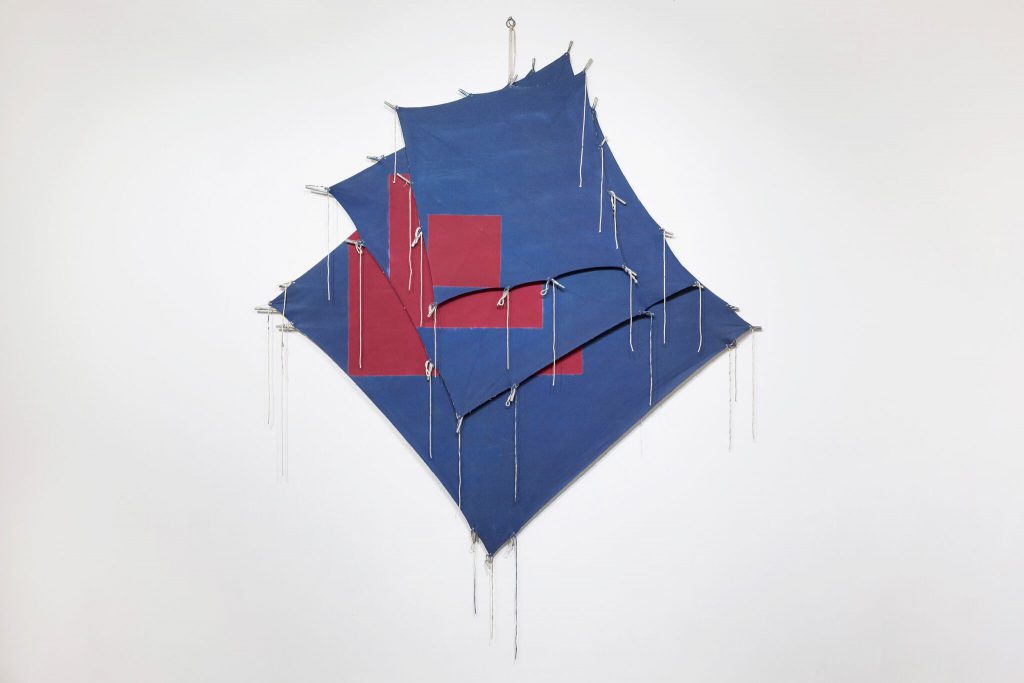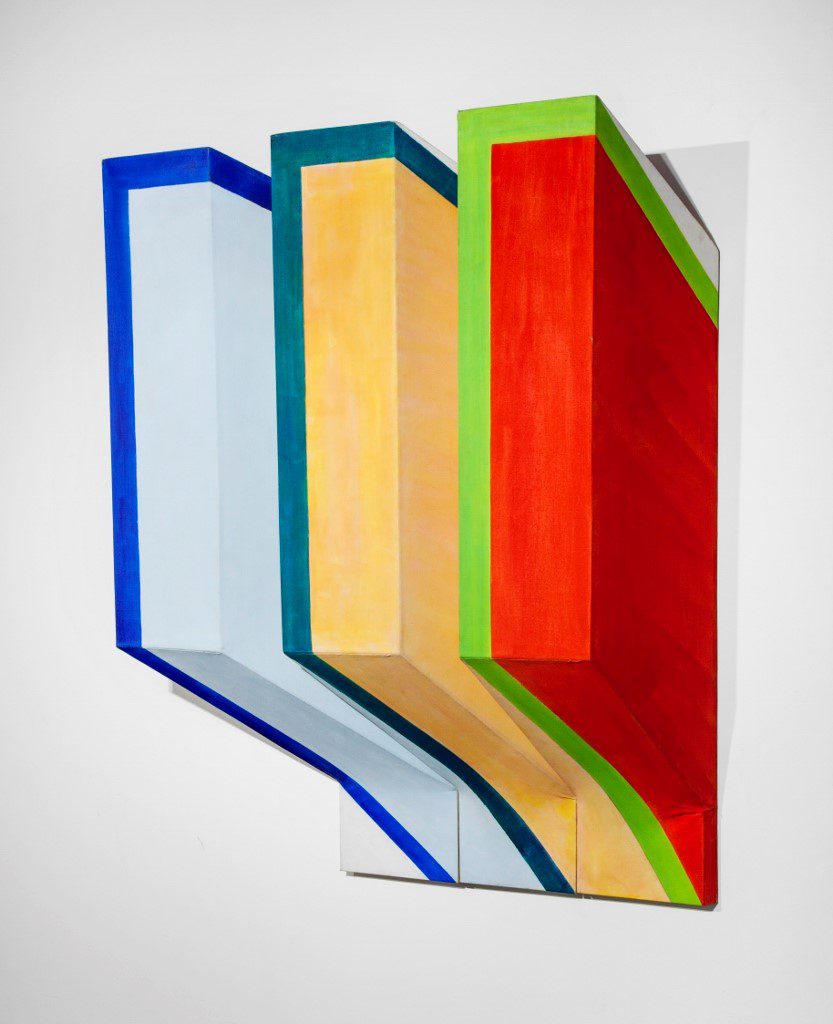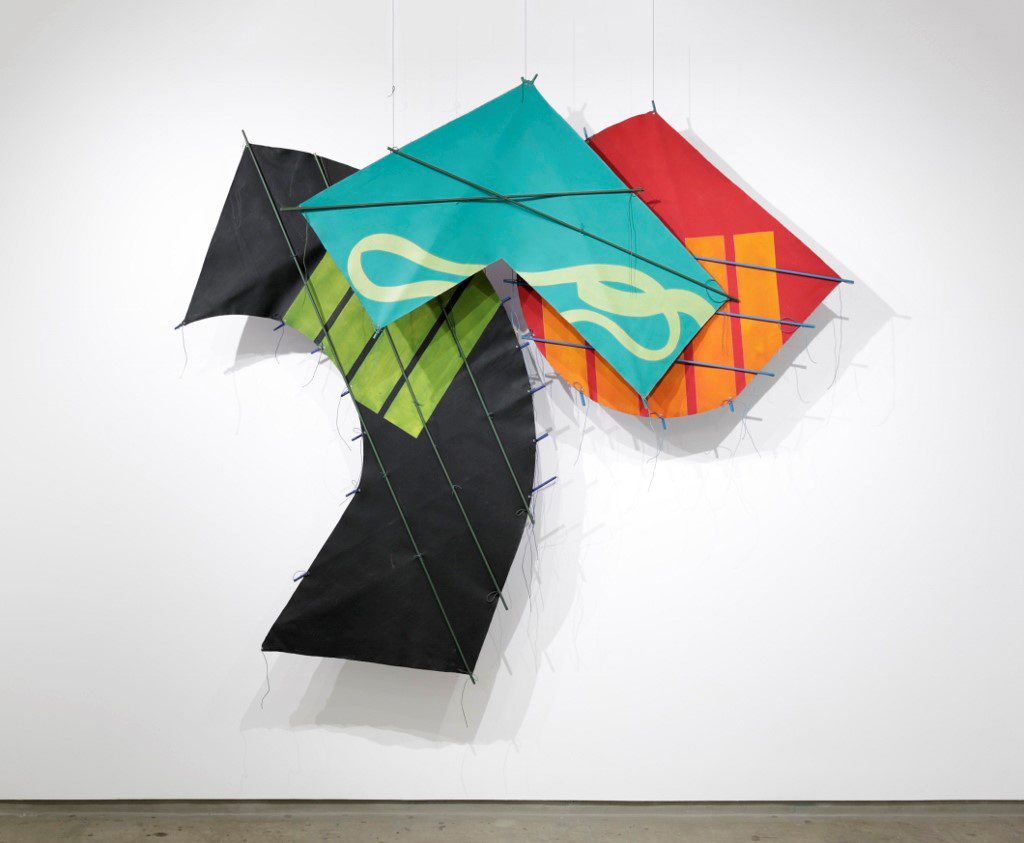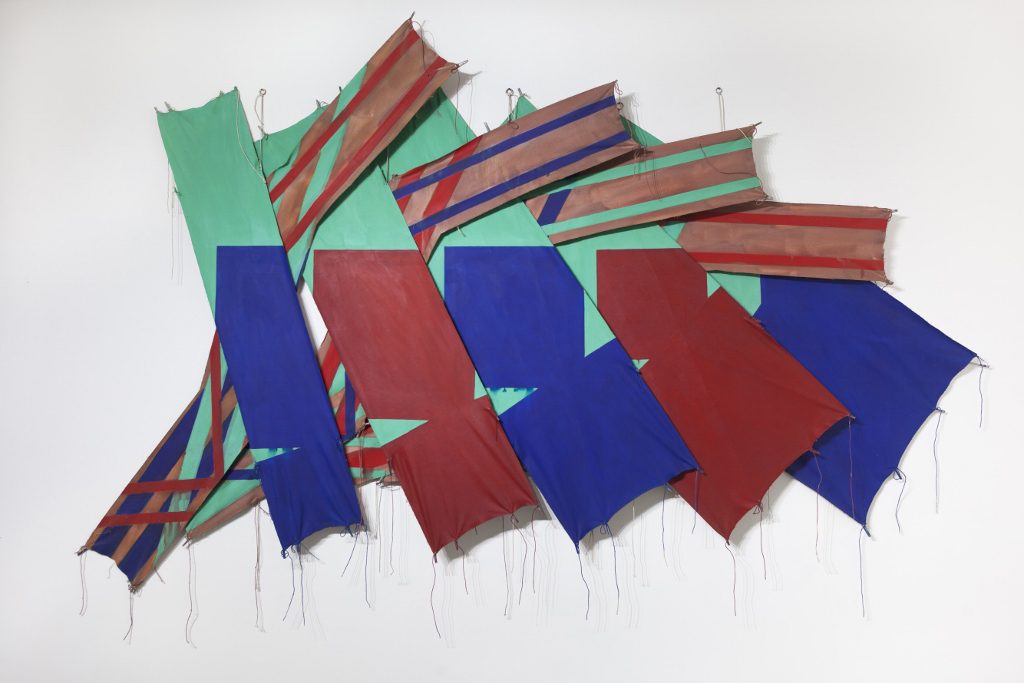Richard Smith: The Incredible Lightness Of Being

Richard Smith has never tried to be mysterious. Indeed, he has programmatically rejected illusionism as optical trickery, intentionally exposing how his works are made, what they are made of and the sources of their inspiration. In the early Sixties, he was at the center of the “swinging London” scene that revolved around the Institute of Contemporary Art where Richard Hamilton launched British pop art. His bouncy imagery alluded to billboards and advertisements like the dancing cigarette packages seen in early Marlborough TV in quirky and witty ways. But he was too much a painter to be a pop artist using obvious representational images and graphic space and design. Smith’s hybrid style was both hip and classic at the same time, and he quickly became a rising star in London.
Trained at the Royal College of Art, in 1959 at age twenty-eight, Smith won a prestigious Harkness Fellowship to the United States where his work immediately caught the eye of the legendary dealer Richard Bellamy. When Bellamy opened the Green Gallery, one of the first artists he showed was Richard Smith, who had his first one man show there in 1961. The paintings referenced pop images and the flickering screen of films and video but their seductively brushed surfaces and soft edged forms anchored them within the tradition of painterly painting. The transparency of his color recalled the greatness of the English watercolor tradition and separated his style from that of the hard edge and minimal as well as the pop artists.
Smith has spoken about his debt to Mondrian. He cites Broadway Boogie Woogie and Mondrian’s experience as an expatriate in New York as a parallel to his experience of moving from London to New York. “The New York I saw when I first went there in 1958 wasn’t that different from the one that Mondrian would have known in the Forties. I think that Mondrian, too, coming from Paris and London, must have felt that this was an exhilaratingly modern place. I think one thing that must have affected him is the light you get there: New York is an immensely bright city. The light there is tremendously sharp.” What he liked about Mondrian best was that his paintings were not programmatic but intuitive, a fact often ignored by those who think only of Mondrian’s earlier paintings rather than the constant shifting involved in the complex creation of Broadway Boogie Woogie.
Returning to England in 1963, Smith gained critical acclaim for extending the boundaries of painting into three dimensions, creating sculptural shaped canvases with monumental presence. Literally protruding into the gallery, the contoured structures radically altered the spatial qualities of his painting, exploring a newfound tension between volume, color and surface. The shaped paintings of the period added a shaped extension to the rectangular canvas, implying they might jump off the wall to become three-dimensional sculpture like the work of his friend Frank Stella. However, Smith always identified himself first and foremost as a painter, a creator of images not objects. Recently Tate Britain–the permanent collection of historic art– acquired Piano from the series of large-scale relief paintings shown at the Kasmin Gallery in London in 1963 that placed Richard Smith at the forefront of the emerging avant-garde.
Despite his success in London, Smith felt the pull of New York. He returned to the United States where he got a loft in SoHo and became part of the exciting world of young pop and minimal artists settling there. In 1964, he married Betsy Scherman, a chic and vivacious American girl. He was acknowledged as England’s contribution to cutting edge art when he won first prize at the São Paulo Biennial in 1967. Then in 1970 he was chosen to represent Great Britain at the Venice Biennale. It seemed that metaphorically the world was his oyster, but possibly he did not like oysters. In 1968 he bowed out of the bright lights, big city of New York to return to England. The young couple moved to the seaside town of Bath, where the Smiths could concentrate on his art, far from the madding crowd.
In Bath, Smith found master carpenters able to construct the complex works that spilled out into the gallery space in a dramatic projection. In the historic resort, the Smiths lived on the elegant Royal Crescent, known for its Palladian architecture and for gambling and the lavish aristocratic parties where Georgina, Dutchess of Devonshire, held court in the eighteenth century. Finding the constructions cumbersome to paint on and almost impossible to budge, Smith decided to move back into the studio where he could work in a more direct manner that did not involve elaborate carpentry.
In 1968 he moved with his family to East Tytherton, a small village in Wiltshire near the great megalithic complexes of Stonehenge and Avebury. This gave him more time to experiment and to develop highly sophisticated new forms. His palette changed to more muted colours and his way of working changed as well. He invented new forms that were light and buoyant that he could move himself. In these radically reductive paintings, he removed the canvas entirely from conventional wooden stretchers, and began to emphasize the literal quality of the canvas surface as a piece of cloth, thus undercutting any residual illusionism.
These works became known as the “kite paintings” because they resembled the cloth and paper painted kites that the Smith family enjoyed flying. The kite paintings were first shown in New York in 1971 and were included in the retrospective of Smith’s work that the Tate Gallery organized in 1975 that established Richard Smith as a major artist, albeit one with a tendency to nomadic wandering, a personality as hard to pin down as the imagery of his paintings.
I was always a fan of Smith’s work and continued to follow his progress over the years. However, there are those things you never knew about friends you thought you knew really well. For example, I never knew Richard Smith served with the Royal Air Force in Hong Kong. So perhaps this theme of kites, a favorite Chinese art form, was not so strange. The delicacy of the kite paintings also recalls the refinement of Japanese origami and gives these works an Asian feeling of elegance and detail. Rather than using a conventional stretcher, in the kite paintings, the painted canvas is pulled taut by cords and aluminum tubing, which act as linear elements in the works. Smith stressed the edges of a painting, which are torn and ragged, and thus literally pieces of cloth. The research he did in the kite paintings regarding the deconstruction of painting paralleled the discourse of the Support/Surface group in Paris as well as the move by his New York contemporaries to pursue an analytic attitude toward what constituted the essence of painting. But Smith was never at home in a group and thus missed out being anointed by Clement Greenberg as a post painterly abstractionist, even if that was an accurate description of Smith’s style.
The English countryside was very pastoral and serene, but too far removed from the international art scene and in 1978 the Smiths moved back permanently to the U.S. The Seventies in New York were dreary and dangerous and no place to raise a family. Eventually Smith once again moved to the country, this time to Long Island where he continues to live and work. For reasons of personality or psychology, Richard Smith was an insider who chose to remain an outsider. He was clearly having a dialogue with color field painting and with the literalism of specific objects and minimalism, but he preferred not to pontificate on the subject. His activity was always at a distance from that of the group. He acknowledged, without buying into, the graphic immediacy of pop art or the insistence on flatness as the sine qua non of high modernist painting that required staining color into cloth and effacing brushwork as optically distracting.
Throughout his career, Richard Smith refused to be a theoretician or cite dogma or to become part of any given circle or style. Yes, the kites are shaped paintings– but only in their own and not any generic sense. They hang lightly, gingerly from an exposed hook, their balance, although carefully engineered, seemingly effortless. They remain fascinating because they occupy two zones of consciousness at the same time. They are neither this nor that, not entirely image nor entirely object. They are brilliantly resolved in terms of composition and color relationships, but not in terms of their status as things in the world.
Color and light, as much if not more than surface and edge, remain Smith’s principle preoccupations. Smith’s thoroughly original palette, his unexpected slightly off shades and tints and his mix of colors from the divergent worlds of fine art, textiles, advertising, cinema and nature distinguishes his painterly style. He invents colors as much as he invents shapes, something one could never say of the familiar contrasts of most hard edge or color field painting. Not until the late work produced when he moved to the heart of Renaissance Italy did Al Held create a palette as extensive and original as that of Richard Smith. Indeed, the two seem to stand apart as alchemists of color, willing to use and combine every kind of color from that of the old sand modern masters to the tones and tints of the countryside in all seasons to the artificial brash colors of industry and technology. And with all the talk about color field painting, this has neither been noted nor discussed in any meaningful way, perhaps because Held and Smith were too independent to be acknowledged by Greenberg who demanded fealty to his authority from those he promoted.
Smith fit no mold. In an America besotted with its Americanness, he was the Brit. In England, he was a deserter from the empire to the colonies. Fully cognizant of the self-reflexive act that defines the modernist mind, Smith references the tools, the vernacular, the elements of which paintings and pictures are made. The canvas remains a rectangular piece of cloth, but now it may be skewed to hang as a diamond reminding one of van Doesburg’s animation, of Mondrian’s strict horizontal and vertical rectangles (for which Mondrian never forgave him).
The stretcherless paintings are surface and surface alone. They take their position as a result of gravity. In the kite paintings, thread, string, ropes or tapes articulate the thinly painted canvas ground. Vertical streaks of liquid paint allowed trickling from a geometric shape whose edges thus are blurred. Fragility is part of the content, a characteristic Smith shares with the delicate constructions of Richard Tuttle, or the wax surfaces of Jasper Johns and a younger artist like Martin Kline.
There is an implied reference not only to the buoyancy of kites, but also to the tension of animal hides stretched to dry into usable skins. Cloth explicitly remains cloth, but the stretching into the bowed shape of kites creates a tension that is clearly physical but can be read as emotional as well. The work is sophisticated, subtle, elegant and precise; yet the effect is as artless, and as magical, as Fred Astaire dancing up the walls in a famous film sequence. In plant of fact, Richard Smith has always reminded me of Fred Astaire: no sweat, no tears, perfectly poised, making long hours of tortuous preparation look easy and artless.
With the kite paintings, Smith challenges the rectangle as the unique field of painting. He deconstructs the planes that in Cubism recede illusionistically from the surface and makes each an individual piece of flat cloth that can be physically in back or in front of the other. In other words, he turns Cubism inside out. Smith’s use of perspective is intentionally unconvincing and self-cancelling and contradictory so that flatness always triumphs against any possibility of implied illusionism. Rather than depicting spatial recession, Smith uses perspective as surface patterning, lines and vectors that are interrupted before they can create a convincing illusion of spatial recession. Smith performs the equivalent of a high wire act by remaining faithful to the tradition of Western painting while boldly challenging its conventions. This is no easy way to make art; rather it is a very tough line to maintain.
There are many intentional contradictions in Smith’s works: for example, adopting the diagonal as opposed to the square as orientation. Van Doesburg’s daring introduction of the diagonal into his work was enough to cause a rift between the two men. The fundamentally geometric organization of forms characteristic of Smith’s work references hard-edge mechanical Constructivism, but it is contradicted by the often pastel landscape palette and lyrical brushwork typical of Smith’s style.

But it is precisely the tension of contradictions that keeps his work consistently alive and interesting. The kite paintings defy the conventions of the rectangle. They are torqued and twisted in real space, rarely resting comfortably against the wall. The aluminium bars on which the canvas is stretched as well as the strings read as literal things at the same time as they function as drawing.
Richard Smith has a characteristically English reticence and dislike of drama or the emotional expressionism and triumphal imagery we associate with American or German art. He has painted very large works and some of the kite paintings are in multiple parts that can cover an entire wall. Although he has made monumental work, one never thinks of him as a monumental painter. In fact, it is virtually impossible to categorize his work which at first had an oblique relationship to pop art, and then to both post painterly abstraction as well as shaped paintings. The unwillingness to trash tradition and decorum is part of Smith’s style, which, no matter how experimental, continues to be anchored firmly within the tradition of painting and high art.
There is a highly personal quality to his works, which although coherently organized on geometric principles have much of the quality of landscape painting because of their transparent washes and painterly style. The canvases pulled off the stretcher look relaxed, but what they are most about is tension, which is why, as opposed to graphic pop and stained color field painting that are experienced in an instant, they continue to be interesting.
Smith has also done installations of kite paintings hung freely in three-dimensional space where they float over the heads of spectators. The fascination of the kite paintings resides rather in the fact that they are both and neither images and objects. Above all, however, they are paintings that come out of a tradition of painting and push it in new directions. Ironically, this is the direction that many young artists, sick of the rhetoric of heroism and gigantism, are exploring. This new generation of painters is discovering the work of the French group Support-Surface that is suddenly having a Renaissance both in Paris and New York. Smith’s kite paintings have much in common with the work of these painters who detached the canvas from its support in the late Sixties and Seventies. His deconstruction of the elements that constitute the conventions of easel painting is however more sophisticated and ambitious in its stubborn commitment to color contrast, light and surface articulation as well as a redefinition of drawing.
The kite paintings extend the research into both literalism and constructivism. Emphasis on the edge extends the shaped canvas discourse. The tension between the superficially casual and the actuality of a disciplined equilibrium. Like Fred Astaire, Smith makes the difficult look easy, the precisely choreographed look casual. The work is elegant and refined without losing its playfulness, its incredible lightness of being. His works are serious investigations of the nature of painting, which never become simply academic statements of formal problems.
The English are known for their immense literary achievements rather than for their signal contributions to the history of painting. But when an exceptional British artist looks back to Constable and Turner, incorporating their technical skills and capacity to create texture and radiance in a thoroughly modern style, then the result can be a Howard Hodgkin, a David Hockney or a Richard Smith. Within this charmed circle, however, Smith is unique in his ability not only to revive and maintain the tradition, but also to push it forward to the point that it can stand with the most progressive, radical and inventive art of his time.
© Barbara Rose 2015
All images © Richard Smith. Courtesy of Flowers Gallery London and New York.



